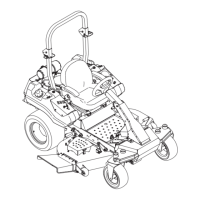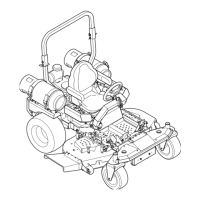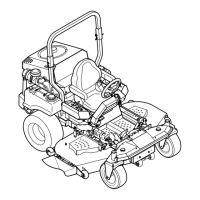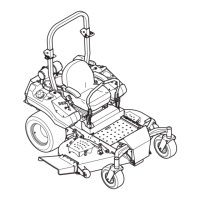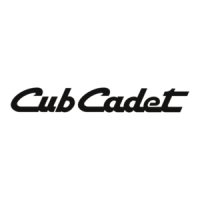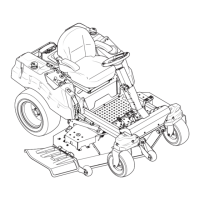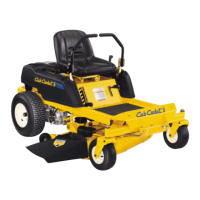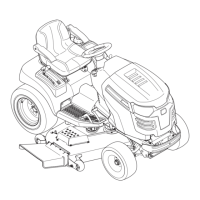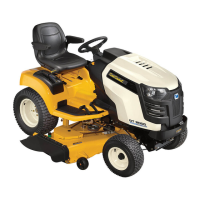Section 6— Maintenance & adjuStMentS28
Battery
CALIFORNIA PROPOSITION 65 WARNING!
Battery posts, terminals, and related accessories
contain lead and lead compounds, chemicals known
to the State of California to cause cancer and
reproductive harm. Wash hands after handling.
The battery is sealed and is maintenance-free. Acid levels cannot
be checked and fluid can not be added.
• Always keep the battery cables and terminals clean and
free of corrosive build-up.
• After cleaning the battery and terminals, apply a light coat
of petroleum jelly or grease to both terminals.
CAUTION: If removing the battery for cleaning,
disconnect the NEGATIVE (Black) wire from its terminal
first, followed by the POSITIVE (Red) wire. When re-
installing the battery, always connect the POSITIVE
(Red) wire its terminal first, followed by the NEGATIVE
(Black) wire. Be certain that the wires are connected to
the correct terminals; reversing them could result in
serious damage to your engine’s alternating system.
Battery Storage
1. When storing the tractor for extended periods, disconnect the
negative battery cable. It is not necessary to remove the battery.
2. All batteries discharge during storage. Keep the exterior
of the battery clean, especially the top. A dirty battery will
discharge more rapidly.
3. The battery must be stored with a full charge. A discharged
battery can freeze sooner than a charged battery. A fully
charged battery will store longer in cold temperatures than hot.
4. Recharge the battery before returning to service. Although
the tractor may start, the engine charging system may not
fully recharge the battery.
Tires
Check the tire air pressure before each use. Inflation pressure
of the rear tires is important for stability while the mower is in
operation. If the tire diameter is not equal between the two tires,
the mower will pull to one side. Keep the tires inflated to the
recommended pressures. Improper inflation will shorten the tire
service life. See the tire side wall for proper inflation pressures.
Observe the following guidelines:
• Do not inflate a tire above the maximum pressure shown
on the sidewall of the tire.
• Do not reinflate a tire that has been run flat or seriously
under inflated. Have a qualified tire mechanic inspect and
service the tire.
• Balance inflation pressure between the rear tires to help
maintain straight travel (see tire side wall for proper pressure).
• Keep the valve caps tightened to prevent air pressure loss.
Inflation Pressure
Rear Tires — 12 psi
Front Tires — 14 psi
Leaking Tires
When a flat tire occurs, repair or replace immediately. The normal
procedure is to remove the wheel and replace it. If a tire is
getting soft, park the mower on the nearest level, paved area.
1. Rear Tire
a. Put blocks on each side of the opposite traction
wheel and jack up the tire that leaks about an inch
off the ground.
b. Loosen and remove the lug nuts and remove the wheel.
c. Mount a wheel and tire, replace the lug nuts, and
using a torque wrench, tighten them to 44-50 ft-lbs.
2. Front Tire
a. Set the park brake and block both rear tires and raise
the front tire so that it is an inch off the ground.
b. Loosen the flange lock nut and remove the spacer,
hex screw and two flat washers from the yoke. The
wheel will drop free.
c. Slip the hex screw, spacer and one flat washer
through one side of the yoke, then through the
wheel to the other side of the yoke.
d. Place a flat washer and a flange lock nut on the hex
screw and tighten to 44-50 ft-lbs to secure the wheel.
e. Lower the mower off the jack and continue mowing.
The wheel with the leaking tire should be inflated to 20 psi for
the rear tire and 14 psi for the front tire . Then place the wheel in a
large bucket of water. Carefully inspect the tire, rim and valve for
escaping air bubbles which indicate a leak. Mark each leak with a
yellow marking crayon and then deflate the tire to 8 psi and repeat
the inspection. If the leaks you find are pin hole size to ⁄” diameter,
the tire can be repaired. If the leaks are larger than ⁄” diameter, the
tire cannot be repaired. If the tire bead is damaged, the tire can be
repaired or the tire will have to be replaced.
Lubrication
• Using a pressure lubricating gun, lubricate all grease
fittings and points as noted in the Lubrication Chart.
• Lubricate all other pivot points with a quality lubricating oil
as noted in the Oil Chart.
Spindle Pulleys
Once a month remove the belt covers to remove any
accumulation of grass clippings from around the spindle pulleys
and V-belt. Clean more often when mowing tall, dry grass.
Pump Control & Pedal Control Area
Blow out or clean out the pump control area under the floor pan
and the pedal control area under the foot rest after each use.
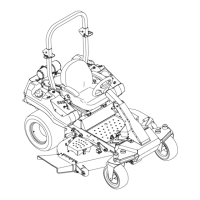
